Dec 27, 2025
Dec 27, 2025
As per my plan I was to write about the lithosphere-one of the most important spheres of our environment. Instead I am writing about energy today, because I am back from one of the most exciting trips to a power plant.
Our country is like a teenager heading for adulthood. There are ups and downs in this growth phase till the final stage is reached. A teenager needs lots of protein to grow properly. Similarly a country at this stage needs plenty of power. Alas, in this field we are facing a big crisis and it is one of the major hindrances in our growth I feel.
In our country we have three main sources to generate electricity, coal, hydro-power and the nuclear power. Our major chunk of electricity is dependent on coal. The aftereffects of which are becoming clear now! Singrauli, which is often quoted as the energy capital of the country lies partly in U.P. and partly in M.P. Ever since coal seams were discovered in Singrauli in 1840, the area’s development revolves around exploitation of coal for generating electricity. Country’s top five mega thermal electricity producing plants have come up in this area. Establishing a power plant in an area rich with coal deposits is to cut down the cost of transportation of coal.
We all know that this coal is due to decay and conversion of the rich flora of the Carboniferous Era (period between approximately 359 million years to about 299 million years ago) from wood to coal. Naturally the fossilized coal contains plenty of carbon-the source of energy. But it contains many other elements too which are bad for our environment. An analysis reveals that the Singrauli power points belch out 720 kilograms of mercury every year. The impact of which is already visible on the residents. A study by the Central Pollution Control Board shows that Singrauli is one of the 22 critically polluted areas of the country. The impact of mercury on the health of the people is such that it can cause permanent damage to brain, the Central Nervous System and the developing fetus.
It is not mercury alone which is scaring, combined with fly ash it is becoming a deadly poison. The fly ash is a by-product of coal fired power plants. Indian thermal power plants produce about six million tons of fly ash annually and five to six feet high piles of fly ash can be seen occupying the agriculture fields of Singrauli. A typical example of, power at the cost of agriculture! Not only agriculture the fly ash in the air in Singrauli area, a report of the Industrial Toxicology Research Centre at Lucknow says that ‘over 1200 persons there were clinically examined. The major finding was that mean mercury blood levels and mercury levels in the hair were significantly higher in Singrauli residents than in the control population. Children had respiratory problems, diarrhea, abdominal pain, and worm infestation. Lower IQ levels were also observed in some children. Headaches, still births, menstrual irregularities and sterility were some of problems experienced by the women living in this area.’
In a nutshell, the coal fired, thermal power plants are proving to be a major environmental hazard. Singrauli does produce more than ten percent of India’s Power supply-but at the cost of health of the people and the agriculture. It is imperative that alternative sources are need of the hour. Moreover, the sources of fossil fuel are not inexhaustible. A study says they will not last more than the year 2240. Some scientists estimate much less time before they are consumed by us.
We have a great potential in hydro-electric power, as it is inexhaustible and clean. But of late problems are coming up, particularly with reference to the hydro-electric plants of Uttarakhand. Groups of well-meaning and highly educated saints are agitating that no new plants should come up in the Ganga and its tributaries in this hill state, as there is a risk of Ganga losing its discharge due to these power plants. I do not want to contradict them here, but yes I will certainly add a pointer. After the Ganga canal is taken off from Hardwar the discharge of Ganga during the summers turns lean till Bulandshahr. And after Bulandshahr the Ganga becomes a mighty Ganga again. From where does it get water again? The only major river which joins Ganga is Ramganga, which is further downstream, about 400 km from Haridwar. The River gets its water supply from the groundwater. It runs on a give and take basis along its entire length in the plains.
The power plants are of course not affecting the flow of Ganga in the plains. But there are reasons for these power plants to turn really scary in the event of an earthquake, landslide and or reservoir induced seismicity. While constructing the hydro-electric plants in the Himalayan terrain all precautions are taken and all parameters are studied in detail for years before designing the structure. Yet sometimes the nature plays truant. A landslide in Tibet during a heavy downpour blocked a lake from which originated one of the tributaries of the Sutlej. These slides temporarily dam the flow of water. This is what happened in 2005 in Pareechu River in Tibet. The river was blocked due to landslide and a lake was formed. The day the temporary blockade burst Pareechu and Sutlej experienced flash floods downstream. The flash floods are very hazardous. In 1997, and 2000 such flashfloods in Sutlej had already caused considerable damage to Nathpa -Jhakri Power plant. Some 70 bridges of the plant area were washed away by the floods and a few hundred people lost their lives.
Similarly, in Tibet in a single incident nearly 30000 people perished in a hydroelectric power plant.
When a dam comes up across a Himalayan river for power generation, we are generally scared of the dam burst. The possibility of which is negligible as the dams are designed taking in to account the worst scenario. But the entire river valley upstream or downstream of the dam cannot be re-designed to contain the flash floods. Thus the protest for no more power plants in the Ganga valley in Uttarakhand is somewhat justified, but not for the reasons of the river flow. However such protests are not fully justified, because we do need power to race ahead with the development of the country.
With coal fired plants threatening the environment and the hydroelectric plants facing closure due to the threats of the protestors leaves only the third option, that is, the nuclear power. Of late, suddenly there has been a spurt of protests against nuclear power. So much has been the protest that the government has stopped accelerating the pace for increasing the power generation capacity.
Is nuclear power really harmful for the flora and the fauna has been a question haunting my mind for some time? If it is so then naturally we are also in the line of fire of the nuclear power. The recent mishap at Fukushima is one of the main causes of fears amongst the general public. But if we really examine, the deaths at Fukushima have not been due to radiation. People died there because of the tsunami. December, 2004 tsunami which devastated vast coastal areas of the eastern coast in south India are fresh in our memories and it is but natural that a tsunami of the type that struck Fukushima can spell disaster on the nuclear facilities along the coast.
However, a plant away from the coast on the banks of the Ganga canal at Narora, in Bulandshahar district took my fancy. A recent trip brought to fore some of the facts hitherto unknown to me. A trip before the sunrise to the forest surrounding a 1.6 km radius of the Narora Atomic Power Plant (NAP) turned to be an eye-opener. As soon as we entered the gate of the forest a troupe of monkeys took position on the boundary wall in a row, minutely observing us and patiently waiting as if trying to welcome us to their never-never land. In the past two decades I have observed that the rhesus monkeys invading the urban complexes have poor coats-many of them show signs of skin infections. But here the monkeys had glowing coats-a sign of good health!
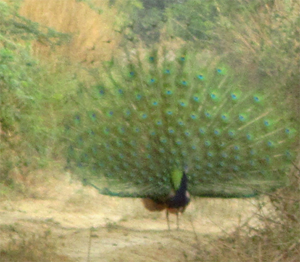 And a sudden call by the peacock made me turn my head to east and there was a male dancing for three females (presumably) and the feathers shining brightly against the first rays of the Sun. I was tempted to get down click a photo, but the officer accompanying stopped me from doing so. Instead he pointed towards a herd of pigs, grazing nearby. Wild pigs can be naughty and attack unprovoked. And I thought discretion is better part of valor.
And a sudden call by the peacock made me turn my head to east and there was a male dancing for three females (presumably) and the feathers shining brightly against the first rays of the Sun. I was tempted to get down click a photo, but the officer accompanying stopped me from doing so. Instead he pointed towards a herd of pigs, grazing nearby. Wild pigs can be naughty and attack unprovoked. And I thought discretion is better part of valor.
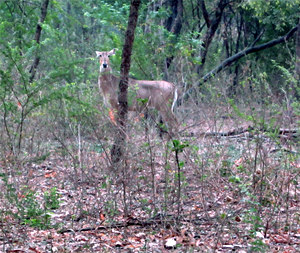 Drive further proved to be like a book and the variety of fauna formed the chapters of the same. There were herds of blue bulls, unmindful of our presence. They had to be literally shooed away to drive on. There were similar herds of dear. And as they ran for cover when our vehicle neared rather too close we could see a group of rabbits also scurrying along. The variety of birds showed that this was a bird watcher’s paradise. Alas, I am a cipher as far as the names of these birds are concerned. But I could spot partridges, wild fowl, pea fowl, cranes, cuckoos and many unknown to me.
Drive further proved to be like a book and the variety of fauna formed the chapters of the same. There were herds of blue bulls, unmindful of our presence. They had to be literally shooed away to drive on. There were similar herds of dear. And as they ran for cover when our vehicle neared rather too close we could see a group of rabbits also scurrying along. The variety of birds showed that this was a bird watcher’s paradise. Alas, I am a cipher as far as the names of these birds are concerned. But I could spot partridges, wild fowl, pea fowl, cranes, cuckoos and many unknown to me.
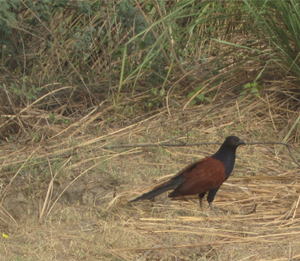 The accompanying officers did tell about the Red Crested Pochard, a bird highly sensitive to quality of water, thrives in the canal and water bodies created in the forest. Also, Indian Skimmer a bird nearing extinction is present in large flock of about a thousand birds in the park during the winters.
The accompanying officers did tell about the Red Crested Pochard, a bird highly sensitive to quality of water, thrives in the canal and water bodies created in the forest. Also, Indian Skimmer a bird nearing extinction is present in large flock of about a thousand birds in the park during the winters.
The variety of fish, crocodiles, ghariyals and giant tortoise in the canal and nearby Ganges again dispelled the myth that the water discharged from the atomic power plant is harmful to the fauna. It is not.
It appears that the forest has a large number of porcupines too; the number of quills we saw was enough to prove their presence. And there was a large herd of cows, which is now ‘trapped’ within the forest of NAP. This area was a grazing ground for the cattle and once the area was totally fenced and secured the cows began to reside there. They are part of the ecology of the forest now.
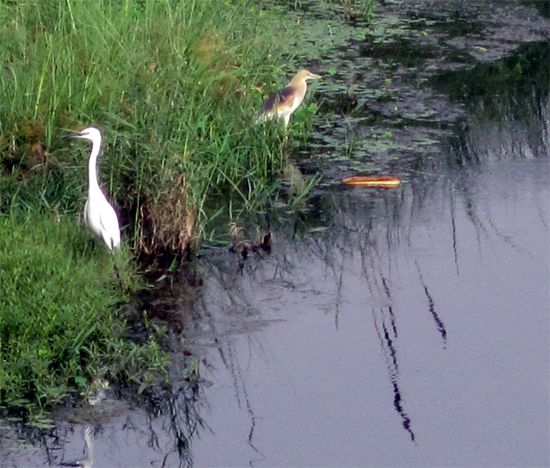
As the Sun began to shine the animals also quietly started to hide under the dense shade of shrubs and trees. Nap officials told that there were tigers too and in the winters they are often seen with their kill. Except the wild elephants, the forest had all the animals. The way these animals and birds were roaming around showed that they were not scared by the two-legged creature and were quite at home.
Most interesting were tiny insects that were abundantly present at the mouth of the confluence of water from the power house drained in to the canal. And there were fish to consume those insects.
It was convincing enough that the environs around the plant were not harmful in any respect to the fauna and the flora and even the aquatic fauna and flora.
But the doubt remained in mind-how these organisms were escaping the radiation? Well a trip inside the plant cleared those doubts too.
The first reaction a common visitor to the plant gets is of fear seeing the steam belching chimneys. In fact these are not the chimneys; they are the cooling towers of the plant. Hot steam that moves the turbines is transferred as hot water through a large diameter pipe to the cooling tower. Tiny droplets of this water are allowed to fall in a spray to a tank at the ground level. From the tank, cold water is pumped back to the nuclear plant as coolant water. While cooling down in the cooling tower a part of water vapor escapes through the funnel at the top. It is this vapor that scars the visitor.
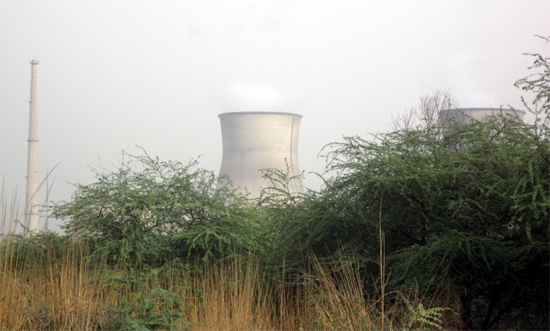
All gases from the plants are allowed to pass through a 140 m high chimney, which has filters to take care of all the metal particles in them. Further above the filters are so sensitive that even if there is a trace of radiation, they shut down the plant.
There is a control room manned round the clock. Those manning it have to undergo rigorous tests of their expertise and then only allowed to sit there. There is a strongly equipped laboratory to monitor all the environmental parameters within the plant, within a radius of 1.6 km, within a radius of 1.6 to five km and also from five to 16 km. As per the distance sampling of gases and materials is done periodically. In addition all the population within a radius of five km of the plant has to undergo periodic checkups at the plant hospital. Not only that the hospital provides free checkup and medicines to this population.
A trip to the plant revealed that the nuclear energy is a clean energy. Of course the risks are there-but so are the risks with a LPG cylinder that we freely use in our kitchens? Should we stop using them because of the risks?
In case of atomic power plants precautions are there at every step. There is a prescribed drill for everything. Even a visitor has to go through a detailed security check up. But that is not to hide anything from the visitor-that is just a precautionary measure.
Compared to a coal fired plant the waste produced from the nuclear plant is nil. But yes the disposal of used fuel is a tricky job-as it has to remain in concrete vaults deep underground for thousands of years to come. Similarly the cost of decommissioning a plant is almost as much as commissioning it. While the nuclear plant life is on an average 30 years, decommissioning it might take as much as 20 years. But that much cost we have to pay to be in the race of development.
Or should we go back to the caves?
Images:
1. A dancing peacock in Narora forest
2. An apprehensive blue-bull
3. Exotic bird
4. Looking for fish
5. Cooling towers and exhaust tower at Naps.
10-Jun-2012
More by : V. K. Joshi (Bijji)

|
Thanks Rajesh. It was indeed a great trip for me. Despite being a geoscientist, indirectly involved in the selection of site process for NAPS I was carrying lots of inhibitions before the visit. After having seen the beautiful forest around and things inside the plant with my own eyes I can now visualise the misconceptions most ppl have abt Nuclear Power. I will surely write about NAPS at many other places. Thanks again. |

|
It felt great to read this article and being employed at NAPS, I feel proud that my power station has conveyed a good message to you, which you are conveying further manifolds. Thanks. |

|
Thanks Conor. I am overwhelmed by your comments. Wes Jackson's quote is really wonderful and it has a deep philosophy behind. Such comments catalyse me to write more. Thank you again. |

|
What a beautifully written piece. It is not necessary to return to the caves but we need to stop our craving for economic growth. It is a dead end (literally). I know you have not missed this point but it is so important I feel I could mention it again. Economic growth is not just the development of an economic system. It means continual growth, more consumption every year and more the next. Nothing can grow for ever and we will destroy our habitat if we keep trying. I might add that however glamorous it may look, very few people profit from economic growth. Most in such a system are in a form of masked slavery. They have been pursuaded to exchange their lives for stuff. HD Throeau said, 'The cost of anything is the amount of life that must be exchanged for it.' I have one more quotation for you, it is from Wes Jackson, "Sustainability means living on contempory sunlight." To do anything else is to live at our childerns expense. I came to this website to read a review of 'The Importance of Living'. Might I refer you to your own page. |